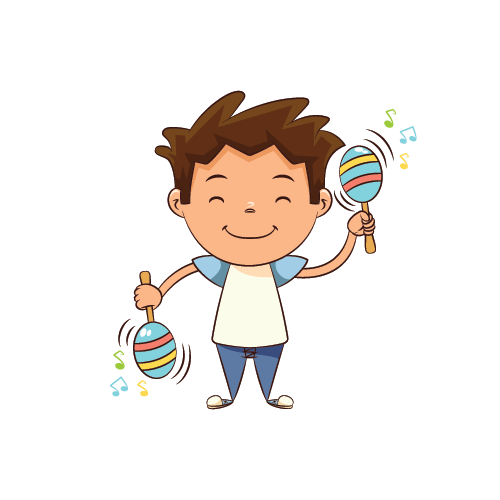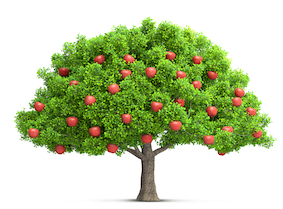
Prep. Lesson 31. Rhythm syllables II
- Woodblock Difficulty:
 Prior learning: None
Prior learning: None
![]() Students will sing and play a rhythm-based game, developing their ability to keep in time, and create rhythmic patterns with percussion instruments.
Students will sing and play a rhythm-based game, developing their ability to keep in time, and create rhythmic patterns with percussion instruments.

![]() Lyrics
Lyrics
Apple tree, apple tree, will your apple fall on me?
I won't cry, and I won't shout if your apple knocks me out.
- Begin by reviewing the song and singing it together as a class.
- Allow each student to select a non-melodic percussion instrument and place it on the floor behind them while standing in a circle.
- Start the game by passing a real apple or apple shaker around the circle in time with the beat while singing the song.
- When the apple stops on a student, they are “out” and pick up their instrument to join the class band.
- Those in the band play the rhythm of the song while the remaining students continue the game.
- As the game progresses, the band grows, and the circle becomes smaller, making it more challenging.
- The game continues until only one student is left in the circle and is declared the winner. Then, celebrate the class band and reflect on how the rhythm grew and evolved as more students joined.
 Success Criteria
Success Criteria
- I can pass the apple in time with the beat while singing the song.
- I can play the song's rhythm on a percussion instrument when I join the class band.
- I can listen and stay in time with the growing band.
![]()
Students will practise distinguishing between beat and rhythm by singing and exploring various percussion instruments.

 Success Criteria
Success Criteria
- I can play the beat or rhythm of the song on my instrument when directed.
- I can work with my group to create and maintain either beat or rhythm.
- I can listen and sing while others play the beat or rhythm.
- Ask students to group themselves by the type of percussion instrument they have, such as woods with woods, metals with metals, and skins with skins.
- Seat students in their instrument groups to organise the sounds.
- Focus on one group at a time. Have them play the beat or rhythm of the song while the rest of the class sings.
- Rotate through the groups, ensuring every group can play both the beat and the rhythm.
- Experiment with combinations, such as two groups playing simultaneously, one focusing on the beat and the other on the rhythm, or different instruments within a group playing distinct parts.
- Use this activity to observe and assess students' understanding of beat and rhythm and their ability to coordinate and collaborate within their groups.
- Wrap up by reflecting on the differences between beat and rhythm and how each contributes to the song.
![]()
Students will explore and identify the relationship between beats and sounds within a song, using visual and physical tools to understand rhythm structure.
![]() Lyrics
Lyrics
What's on your dinner plate?
You must find it hard to wait.
Rice, bread, pasta, meat.
Is it time to stop and eat?
- Sing the song together while clapping, encouraging the children to count the beats as they sing. Confirm that there are sixteen beats in the song.
- Seat students in a circle and lay sixteen paper plates in four rows to represent the beats. Sing through the song again, pointing at each plate to match the beat as you sing.
- Introduce counters, such as fruit/vegetable-shaped tokens or paddle pop sticks, and explain how they represent the number of sounds on each beat.
- Work with the students to determine how many sounds are on each beat.
- Ask selected students to place the correct number of counters on each plate to match the sounds, illustrating the song's rhythm (e.g., 1st plate = 1 counter, 2nd plate = 2 counters, etc.).
- Sing through the song again, this time pointing at the counters on the plates to confirm the sounds align with the beat.
- Encourage discussion about how the beats and sounds work together to form the song's rhythm.
- Reflect on how visual aids like plates and counters can help understand rhythm.
 Success Criteria
Success Criteria
- I can count the beats in the song while singing and clapping.
- I can identify how many sounds occur on each beat.
- I can use counters to accurately represent the number of sounds on each beat.
![]()
Students will develop their ability to internalise rhythm and connect visual symbols with rhythmic patterns in the song.
- Display the song's rhythm on the whiteboard using fruit/vegetable symbols. Larger symbols represent longer sounds, and smaller symbols represent shorter sounds.
- Sing through the song as a class while pointing to each symbol to match the rhythm.
- Ask students to sing the song again, this time using their inner voices while still pointing to the symbols on the board.
- Stop at a random symbol and ask students to identify which word or fruit or vegetable corresponds to that point in the rhythm.
- Repeat this process several times to test their ability to follow the rhythm visually and internalize it.
- Encourage discussion about how using inner voices can help understand rhythm and connect it to visual representations.
 Success Criteria
Success Criteria
- I can follow the rhythm of the song using the fruit/vegetable symbols.
- I can use my inner voice to continue the song silently.
- When the teacher stops on a random symbol, I can identify the correct word.
![]() Students will explore pitch through a visual representation of the song using coloured dots and perform the melody using boomwhackers.
Students will explore pitch through a visual representation of the song using coloured dots and perform the melody using boomwhackers.
 Success Criteria
Success Criteria
- I can identify how colours represent different pitches in the song.
- I can match the coloured dots to the corresponding boomwhacker notes.
- I can play along with the song on a boomwhacker.
- Project the song using coloured dots, each representing a different pitch.
- Begin by asking students why they think the dots are coloured.
- Then, guide them to understand that the colours represent the notes of the song at different pitches.
- Distribute boomwhackers to the students, ensuring the colours match the projected notes.
- Sing through the song as a class while pointing to the coloured dots, helping students connect the visuals to the melody.
- Play the song together using the boomwhackers, following the sequence of colours projected on the board.
- Repeat the song, allowing students to practise and refine their playing.
- Encourage them to focus on matching the pitch accurately to the colours.
- Conclude by discussing how the coloured dots help visualise pitch and how this can make learning music fun!
Suggested lessons
Y1. Beat II

Y1. Beat III

Y1. Beat IV

